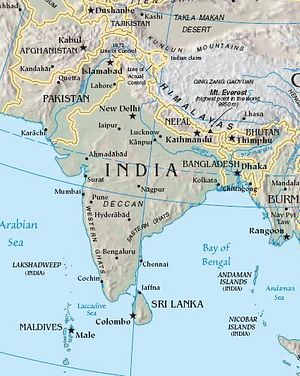A few weeks ago, my colleague Ankit Panda noted that some of Asia’s most fragile states are in South Asia, based on the results of the Fragile States Index (FSI). The ranking’s methodology was determined by numerous social, economic, and political indicators. One thing is clear: South Asian states are relatively weak and many of their governments cannot meet their objectives, such as implementing their own laws. For example, this is clear when one considers the inability of India to implement its own public health policies. According to the sociologist Max Weber, a weak state is unable to maintain a monopoly of violence over its own territory. This brings to mind Pakistan and its abysmal failure to control its own territories and maintain internal security. In fact, most states in the region, including Afghanistan, Bangladesh, Nepal, Pakistan, Nepal, and Sri Lanka score low on the index and are close to failure.
So, why are South Asia’s states so weak? This problem is brilliantly discussed by Francis Fukuyama in his book The Origins of Political Order. In it, Fukuyama argues that South Asian states never developed the bureaucracies or institutions that enabled them to govern their territories effectively. This was due to the fragmented nature of society in South Asia. There are many caste, linguistic, and religious groups in the region which historically only interacted with themselves, though they lived side by side. Additionally, the region was dotted with numerous local rulers, princes, rajas, nawabs, sultans, nayaks, you name it. This enormous diversity made it difficult for any state to impose a single working bureaucracy on the land or for a “normal” civil society to emerge. As Machiavelli noted, it is extremely difficult to rule over a land with many lords. The result of all this for governance is that governments in South Asia have generally hovered above society without really establishing their writ within it. Internal weakness may also be responsible the non-vigorous foreign policy attitudes of many modern South Asian states because it leads to a focus on domestic affairs.
Fukuyama’s ideas can be expanded upon in the South Asian context. Ethnically and linguistically, South Asia’s diversity quite resembles that of another continent: Europe. Yet, unlike Europe, for the most part, it is not broken up into many medium-sized, homogenous states that make effective governance easier. It contains many diverse states, one of which, India has almost as many people as China. Yet, unlike China, India did not go through thousands of years of political unity that allowed the emergence of homogeneity and a uniform bureaucracy. Historically, South Asian states did not last very long, whether big or small. Therefore, the region did not go down the route of both Europe and China which produced more stable states. Comparing India to Europe is a fairly valid comparison for effectiveness: imagine if Europe were a single country today! Its numerous factions and ethnicities would also make governance exceedingly difficult, as is the case in India. The European Union’s various disagreements already offer a glimpse of this.
What are the implications of South Asia’s history for its future? Will it continue to have to deal with weak governance? Will rebellion and internal violence continue to plague most of the region? These are definitely possibilities, especially if governments remain weak. It is clear that governments must do their best to actually penetrate society by implementing basic infrastructure or education. Otherwise, people in areas who do not feel the presence of their government will not care for their own government. This can be seen in areas such as Waziristan and the Maoist-infested parts of India.
It is important for countries in South Asia find ways to unite through both institutions and ideology. It is also important for a country to have a common set of core ideas in order for its people to feel like part of a single community. This will create a sense of nationhood which will ultimately strengthen a country’s sense of identity, making it more likely to survive. Federalism and diversity are fine but too much of either could pull a country’s constituent social groups or regions in different directions which would ultimately weaken the country. Ultimately, each country needs to find its own ideological glue, just as the United States gradually articulated a set of American values over time while other countries turned to ethnic nationalism. Pakistan was founded in order to be a homeland for South Asian Muslims; over time, it has added more layers to its story, such as claiming to be heir to the civilizations of the Indus Valley, distinct from the other ancient kingdoms of the subcontinent. India, on the other hand, has found an identity as a civilizational state, heir of and repository of an ancient civilization.
Ultimately, South Asia’s states are weak due to historical circumstances and the legacy of this for governance. The tragic consequences of this are obvious today. However, in an era that emphasizes development and mass communication, it is possible for states to take measures that will correct their weaknesses. Some states in South Asia may not be able to escape their weaknesses for a while to come, such as Pakistan, but others may be able to strengthen themselves and rise above this legacy of fragility, such as India. The fate of hundreds of millions of people depends on the ability of these states to provide governance.

































